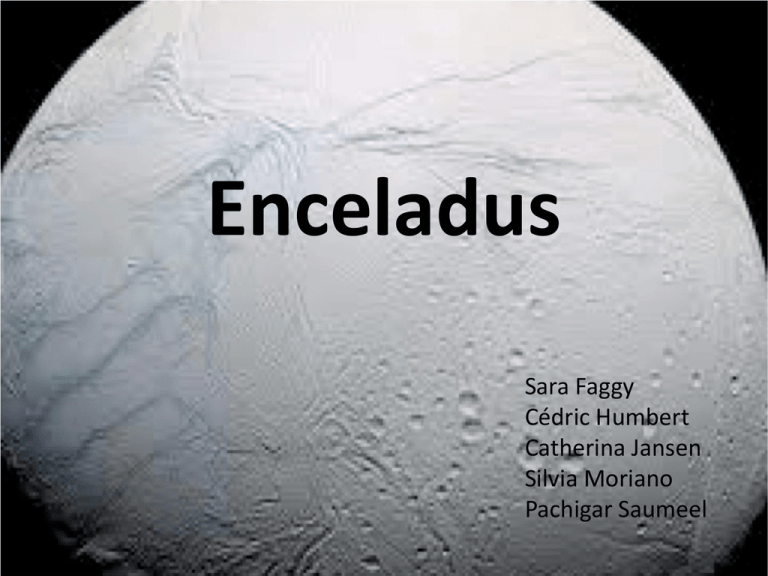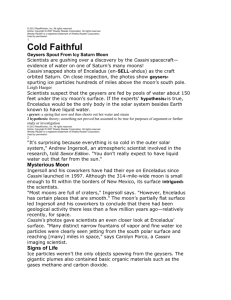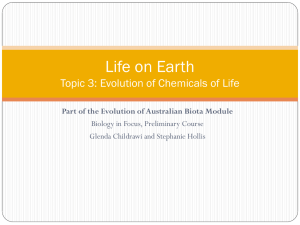Origin of life on Enceladus
advertisement

Enceladus Sara Faggy Cédric Humbert Catherina Jansen Silvia Moriano Pachigar Saumeel What is Enceladus? Athena and Enceladus. Musée du Louvre, Paris, France What is Enceladus? The Astrophysical Aspects When did we first encounter Enceladus? Cassini Mission Cassini Mission Astrophysical characteristics Dimension: 252.1 ± 0.1 km =(0.0395 Earths) Mass: (1.080 22 ± 0.001 01) × 1020 kg =(1.8×10-5 Earths) Mean Density: 1.609 6 ± 0.002 4 g/cm3 Equatorial surface gravity: 0.111 m/s^2 (0.011 3 g) Escape velocity: 0.239 km/s (860.4 km/h) Rotation period: Synchronous Axil tilt: Zero Apparent Magnitude: 11.7 Surface temperature (mean) : 75K Orbital parmeters Major Axis 238 020 Km Orbilat period 32 h 53 min 07s Inclination (to Saturn's equator) 0,02° Eccentricity 0,0045 The Biological Aspects Production of organic compounds by interstellar cloud CO CO2 NH3 CH2OH H2O CH4 C2 and N2 and others organic compounds Production of organic compounds by interstellar cloud Cosmic radiations (UV, gamma rays...)) CO CO2 NH3 CH2OH H2O CH4 Production of organic compounds by interstellar cloud Cyanic acid Formaldehyde Alanine Acetonitrile Acetaldehyde Ethylamine Formamide And other organic compounds..... Enceladus Meteorits and comets as carriers Enceladus Cosmic radiations Degration/other chemical reactions enanthioselective photolysis occurs during the voyage Degradation / other chemical reactions/ enanthioselective photolysis/ and protection Production of L-amino acids, D-sugars, nucleobase like compounds and other precursors of biomolecules L-amino acid (left) and D-amino acid (right) Purine like compounds Impact with the satelite and delivery of survival organic compounds on the crust Production of organic compounds by volcanism Production of organic compounds by volcanism Volcanism Heating of sea salts Production of HCL and mineral ions Catalysis of of follow reaction + Pyrrole Formaldehyde Dipyrrin redox active metal ion chelator Production of organic compounds by hydrothermal vents Production of mineral ions Production of simple molecules like CO2/H2/NO2...., which form organic compounds During the freezing of water, solutes are excluded and chemical reactions occur between the solutes and produce some organic compounds Production of biomolecules by clays Adsorption of organic compound by montmorillonite Structure of montmorillonite Production of organic compounds by interstellar cloud Montmorillonite are able to capture, retain, and protect minerals due to their charged structure. charged compounds and This capacity of adsorption is due to a high cationic interchange capacity and an high area of adsorption. These specificities of montmorillonite permit it to concentrate biomolecules. Montmorillonite presents an enantioselective uptake/protection of compounds, for example montmorillonite retain preferencially L form of amino acids This phenomenon permits some reactions such as the phosphorylation of AMP, amino acids polymerisation of active nucleotides in RNA less than 50 mers (with a preferencial bond formation between 2'-5' or 3'-5' positions) or formation of polypeptidic chain sometimes by recruiting some mineral ions for catalysis.The mechanism for this is temperature, pressure, and pH dependant. Enceladus has the adequate conditions to permit such reactions. What are Extremophiles? ‘Organisms that thrive in extreme environments; if in more than one extreme then called polyextremophiles’ Rothschild and Mancinelli What are Extremes? ‘Everything in Moderation’ Aristotle Group Physical Geochemical Biological Example Temperature , Radiation or Pressure Desiccation, Salinity, pH Nutritional extremes, Extremes of population density. Extremophiles in the case of Enceladus Surface Geothermal Vents Reservoir and Core • CH4, C02, N2 and H2O atmosphere • Temperature Avg. 75K • Trace surface pressure • Exposure to UV Rays • Temperature Avg. 180K • CH4, C02, N2, H2O, C3H8, C2H6 and C2H4 • Temperature Avg. 273K at water reservoir • Temperature Avg. In Core 1000K Extremophiles in the case of Enceladus Surface - Minimal Atmosphere -Very low Temperatures -Dessication - No oxygen Geysers -Varying temperature - Pressure - pH (Not confirmed) Water Reservoir - Has ideal conditions for life Ecosystems on Enceladus We can describe two possible ecosystems that may exist on Enceladus. Methanogen-based community Sulfur reducing-based community Primary producers are methanogens that consume H2. Primary producers are sulfurreducing bacteria. Ecosystems within a tidally heated liquid water reservoir on Enceladus. 4H2 + CO2 → CH4 + 2H2O 4H2: from disotiation of H2O by radioactive decay. SO42-: reaction o oxidants with FeS2. 4H2+ H+ + SO42- → H2S+ 2H2O+ 2OH- Ecosystems on Enceladus We can describe two possible ecosystems that may exist on Enceladus. Methanogen-based community Primary producers are methanogens that consume H2. Ecosystems within a tidally heated liquid water reservoir on Enceladus. Ice cover Ocean Biology: H2+CO2→CH4+H2O H2 4H2 + CO2 → CH4 + 2H2O Rock CH4 CH4+H2O → H2+CO2 Ecosystems on Enceladus We can describe two possible ecosystems that may exist on Enceladus. Methanogen-based community Sulfur reducing-based community Primary producers are methanogens that consume H2. Primary producers are sulfurreducing bacteria. Ecosystems within a tidally heated liquid water reservoir on Enceladus. 4H2 + CO2 → CH4 + 2H2O 4H2: from dissotiation of H2O by radioactive decay. SO42-: reaction o oxidants with FeS2. 4H2+ H+ + SO42- → H2S+ 2H2O+ 2OH- Origin of life on Enceladus Speculations about life on Enceladus are necessarily based on our understanding of life on Earth. Defining the growth requirements for life - Liquid water Enceladus has - Energy source all of these - Carbon - Other elements such as N, P, S. Origin of life on Enceladus Three main categories origin of life on Earth Panspermia Extraterrestial origin of life Organic origin of life Chemosynthetic origin of life Terrestial origin of life Origin of life on Enceladus Panspermia - Extraterrestrial origin of life. -Enceladus would share the same origin and, therefore, the same biochemistry as life on earth. Organic origin of life - Applied to Enceladus: the organic soup model might involve the formation of Enceladus from organic-rich ices similar to cometary materials. Chemosynthetic origin of life - In this scenario, life begins at the interface where chemically rich fluids heated by tidal dissipation emerge from below the sea floor. The Technological Aspects Cassini Instruments: -Cassini Plasma Spectometer (CAPS) -Cosmic Dust Analyser (CDA) -Composit Infrared Spectrometer (CIRS) -Ion and Neutral Mass Spectrometer (INMS) -Imaging Science Subsystem (ISS) -Dual techinque Magnetometer (MAG) -Magnetospheric Imaging Instrument (MIMI) -Cassini Radar (RADAR) -Radio and Plasma Wave Spectometer (RPWS) -Radio Science Subsystem (RSS) -Ultraviolet Imaging Spectrograph (UVIS) -Visible and Infrared Mapping Spectometer (VIMS) Ultra Violet Imaging Spectrograph Ion and Neutral Mass Spectrometer Visible and Infrared Mapping Spectrometer Composite Infrared Spectrometer Imaging Science Subsystem The Future Our Proposal Enceladus at prensent is not completely understood, though the little data collected from Cassini-Huygens shows promise for life. Not being the current focus of the european and american space agencies, due to commitments with studying Mars. If a mission to enceladus ever arises we propose that the following are tested: Test Water Reservoir Check Plumes -Bacterial By Products -ATP -Simple Sugars Check for Sulphur Thank you for your attention References Parkinson, C.D., Liang, M.C., Hartman, H., Hansen, C.J., Tinetti, G., Meadows, V. Kirschvink, J.L. , Yung, Y.L. 2007. Enceladus: Cassini observations and implications for the search for life. Astronomy&Astrophysics , 463: 353-357. Porco, C. 2009. L’inquieto mondo di Encelado. Le scienze, 487: 42-51. Postberg , F.,. Kempf , S., Schmidt, J., Brilliantov, J., Beinsen A. Abel , B., Buck, U., Srama, R. 2009. Sodium salts in E-ring ice grains from an ocean below the surface of Enceladus. Nature, 459: 1098-1101. Spencer, J.R., Pearl, J.C., Segura, M., Flasar, F.M., Mamoutkine, A., Romani, P., Buratti, B.J., Hendrix, A.R., Spilker, L.J., Lopes, R.M.C. 2006. Cassini Encounters Eceladus: Backgraund and the Discovery of south polar hot spot. Science, 311: 1401-1405.











